Tagged with 'Cultured pearls'


The very latest news, musings and opinions from the world of Winterson. Quite simply, a celebration of a jewellery, fashion, culture and the business behind luxury.
-
La Peregrina - Famous Pearl Jewels
La Peregrina - Famous Pearl Jewels
The legend of La Peregrina, one of the world’s most famous natural pearls, suggests that it was found in the mid-16th century near the island of Santa Margarita in the Gulf of Panama by an African slave, who was rewarded for his find with freedom.
At the time this extraordinary pear-shaped pearl was also one of the largest ever found, measuring approximately 17.5mm by 25.5mm and weighing over 11 grams before it was cleaned and drilled.
Don Pedro de Temez, the administrator of the Spanish colony, recognised the pearl's importance and brought it to Spain, where he gave it to the future king - Philip II of Spain. At this time the pearl began an incredible journey of ownership and it remains today one of the oldest and best documented historical jewels.
Philip presented with La Peregrina to Mary I of England, his future wife. Mary wore the pearl as a pendant suspended from a brooch, a jewel she can be seen wearing in a series of portraits from the period. After Mary’s death in 1558, the pearl was returned to the Spanish court where it remained for 250 years, and was worn by the wives of Kings Phillip III and IV.
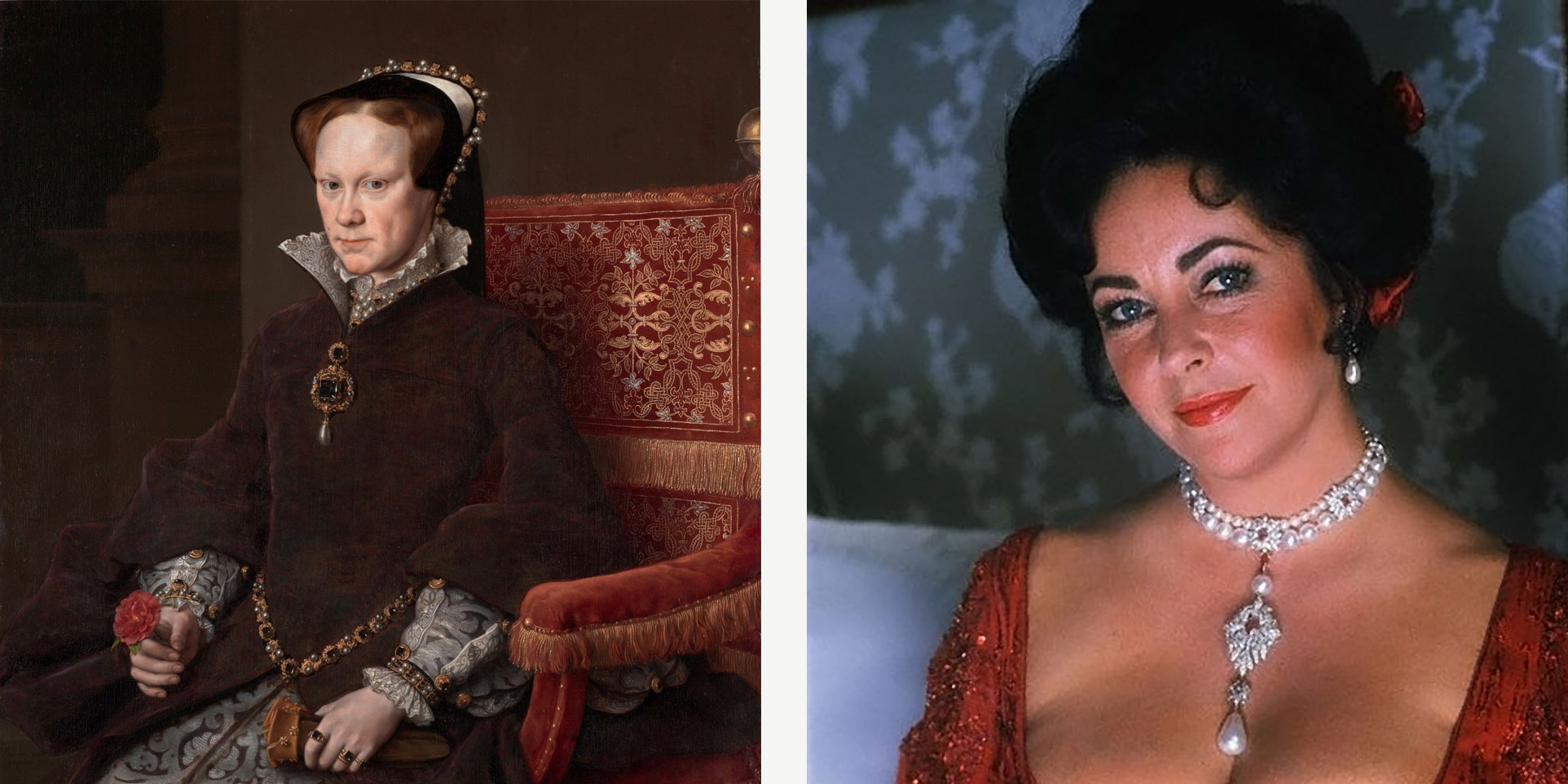
Image 1: Mary Tudor, original artwork by Antonis Mor 1519-1575
Image 2: Elizabeth Taylor, c.1972
In 1808, when Napoleon installed his brother Joseph Bonaparte as King of Spain, the pearl found its way to France. In 1848 the pearl finally made its way to England into the Estate of James Hamilton, Duke of Abercorn. It was during this time it was given the name La Peregrina, which means the “Pilgrim” or “Wanderer”.
La Peregrina remains one of the largest perfectly symmetrical pear-shaped pearls in the world. The Hamiltons sold the pearl for $37,000 at Sotheby’s in 1969 to Richard Burton, as a Valentine Day's gift for Elizabeth Taylor.
It was the exquisite heirloom that sealed one of Hollywood's most tempestuous love stories. Drop and pear-shaped pearls are often made into pendants, but during its history La Peregrina was worn as a brooch, a pendant to a necklace, the centrepiece of a necklace and even a hat ornament. Taylor commissioned Al Durante of Cartier in 1972 to design a ruby and diamond necklace mount for the pearl. The complete piece is quite stunning and truly one of a kind.
When Taylor died, La Peregrina was sold at auction by Christies in 2011 to raise funds for the Elizabeth Taylor AIDS Foundation, which was established by Taylor to help provide direct services throughout the world for people living with AIDS.
Christies estimated the value of La Peregrina to be between $2 million and $3 million, making Lot 12 the second highest valued lot of the auction. In a fitting tribute to the memory of Elizabeth Taylor, the auction of legendary jewels surpassed all expectations, with the sale of La Peregrina for $11,842,500 creating two new world auction records for a historic pearl and for a pearl jewel.
Where, we wonder, will the next stage of its historic journey be taking the Wanderer to? -
Interview with Melanie Georgacopoulos
Interview with Melanie Georgacopoulos
Melanie Georgacopoulos is renowned for her work reinventing the pearl for a younger 21st century audience. Today’s renewed fascination with the gemstone owes much to this young designer, a graduate from London’s famous Royal College of Art. The Winterson Journal talks to Melanie about her new avenue of exploration with the pearl.
Without inhibition, Melanie Georgacopoulos has sliced, drilled, quartered, caged and wrapped pearls in illusions of knots in her mission to bring this extraordinary gemstone to a new generation of jewellery buyers.
Her most recent collection, MOP Shell, directs her inventive energies to Mother of Pearl. Otherwise known as the material nacre, it is produced by mollusks as an inner shell layer as well as forming the outer coating of the pearls themselves.
What drew you to mother of pearl?
Natural Mother of Pearl has been used by many cultures all over the world, to create both expensive and inexpensive items. It is a strong, resilient and iridescent material that has been used for thousands of years, mainly in the form of inlay, which you see a lot in East Asian and Islamic religious art.
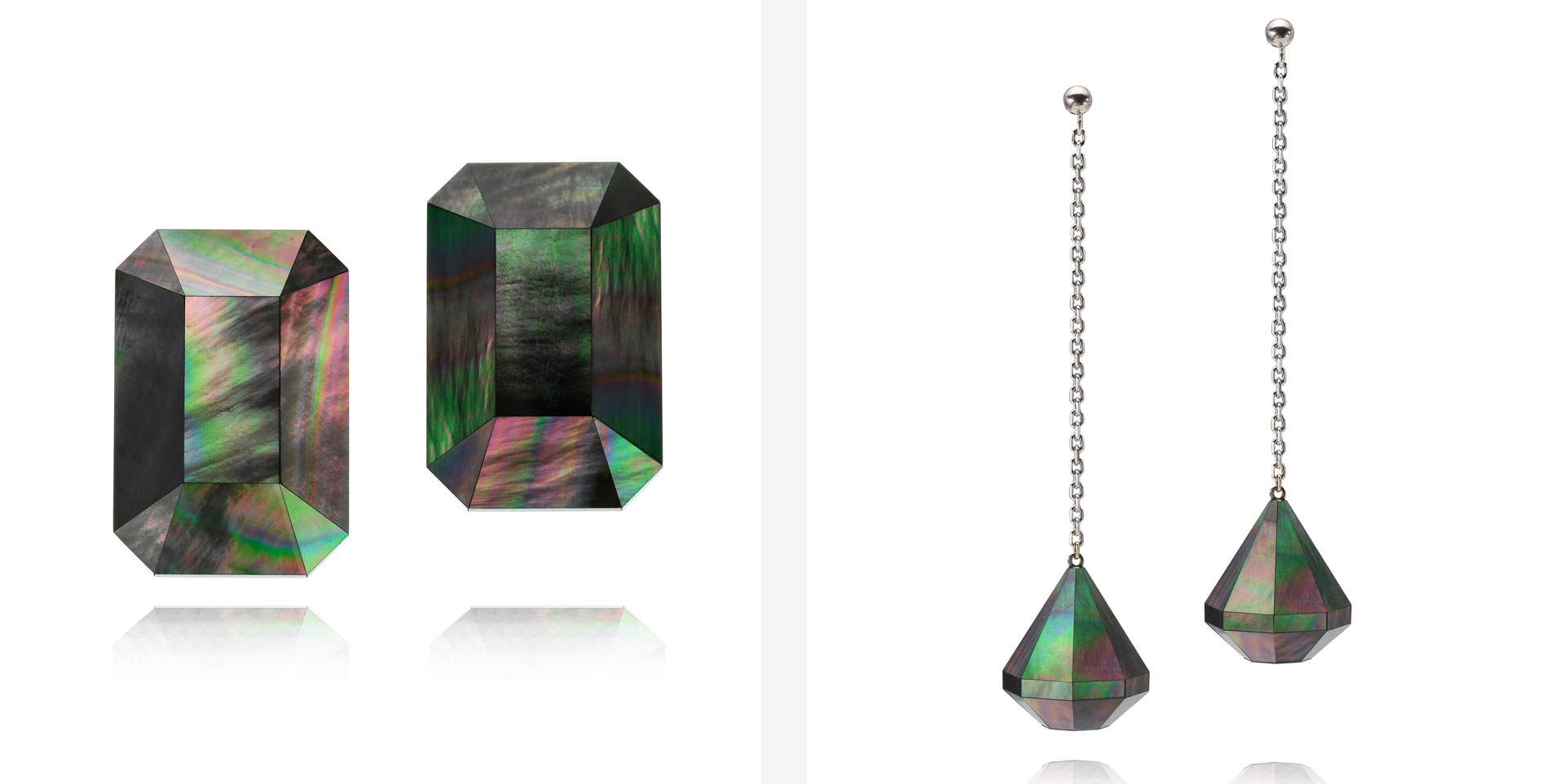
Image 1: MOP Emerald Earrings - Peacock
Image 2: MOP Diamond Dress Earrings - Peacock
At the same time, it was a popular material for more common Victorian household items such as knife handles and buttons, as well as Chinese gaming counters and delicate caviar spoons. I think it’s this heritage as a material that can move from high to low that originally sparked my interest.
You often look for the subversive angle in your design; what was the twist with mother of pearl?
As a material it is more widely used than pearls, but despite its popularity, it has never reached the pearl’s symbolic status. I felt that mother of pearl was ready for a reassessment, in the same way as the pearl felt for me back in 2007 when I first started to play with them in the studio at the RCA.
Pearls were so associated with the twin-set on one hand, and the ostentatious fakes of Coco Chanel on the other, that the gemstone felt like a really rich place to mine deeply for inspiration. Mother of pearl is in the same place really. One rarely sees it used in fine jewellery today and I wanted to explore whether it was possible to challenge those perceptions.
Your pearl collections tend to focus on the monochrome beauty of the gem, where MOP Shell really plays with the fabulous colours of the material. How did it feel to play more with colour?
The collection really aims to celebrate mother of pearl’s qualities as a material, and showcase its various beautiful, rich colors. It comes in soft pink, crème, white, peacock and golden yellow with many variations.
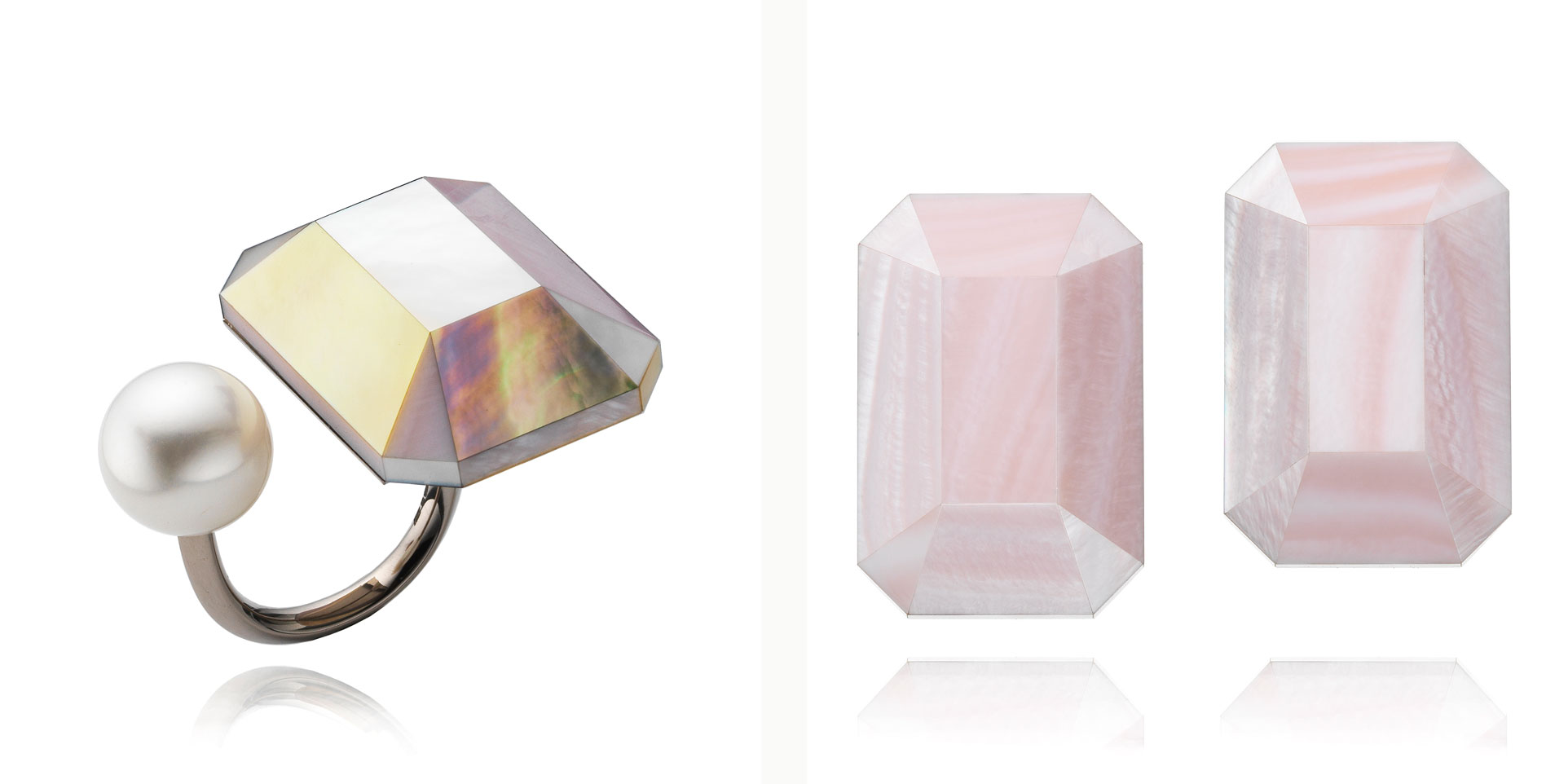
Image 1: MOP Emerald Ring - Multicolour
Image 2: MOP Emerald Earrings - Lavender
It was actually really refreshing to work with a flat material that has such striking colours and work out how to combine them. I’ve enjoyed this so much in fact, that my next collection focuses even more on these diverse colour combinations and how they change depending on the light.
You enjoy exploring the meaning of value in jewellery by playing with the forms of other classic precious gemstones – diamonds and emeralds – and that theme re-emerges here. Can you tell us a bit more about that?
When mother of pearl is used in jewellery, it's mainly seen flat and as an inlaid form. By taking this flat material and creating seamless three dimensional diamond and emerald shapes, I felt I could really push further my exploration into the relationship between gemstones and pearls in contemporary jewellery.
The pearl has moved on and off lists of precious stones over the centuries – from being the height of luxury and value in the time of Cleopatra to being close to worthless in the late 20th century due to overfarming. I think I have always been interested in playing with perceptions of value, asking questions in particular about the value of design and how people perceive that.
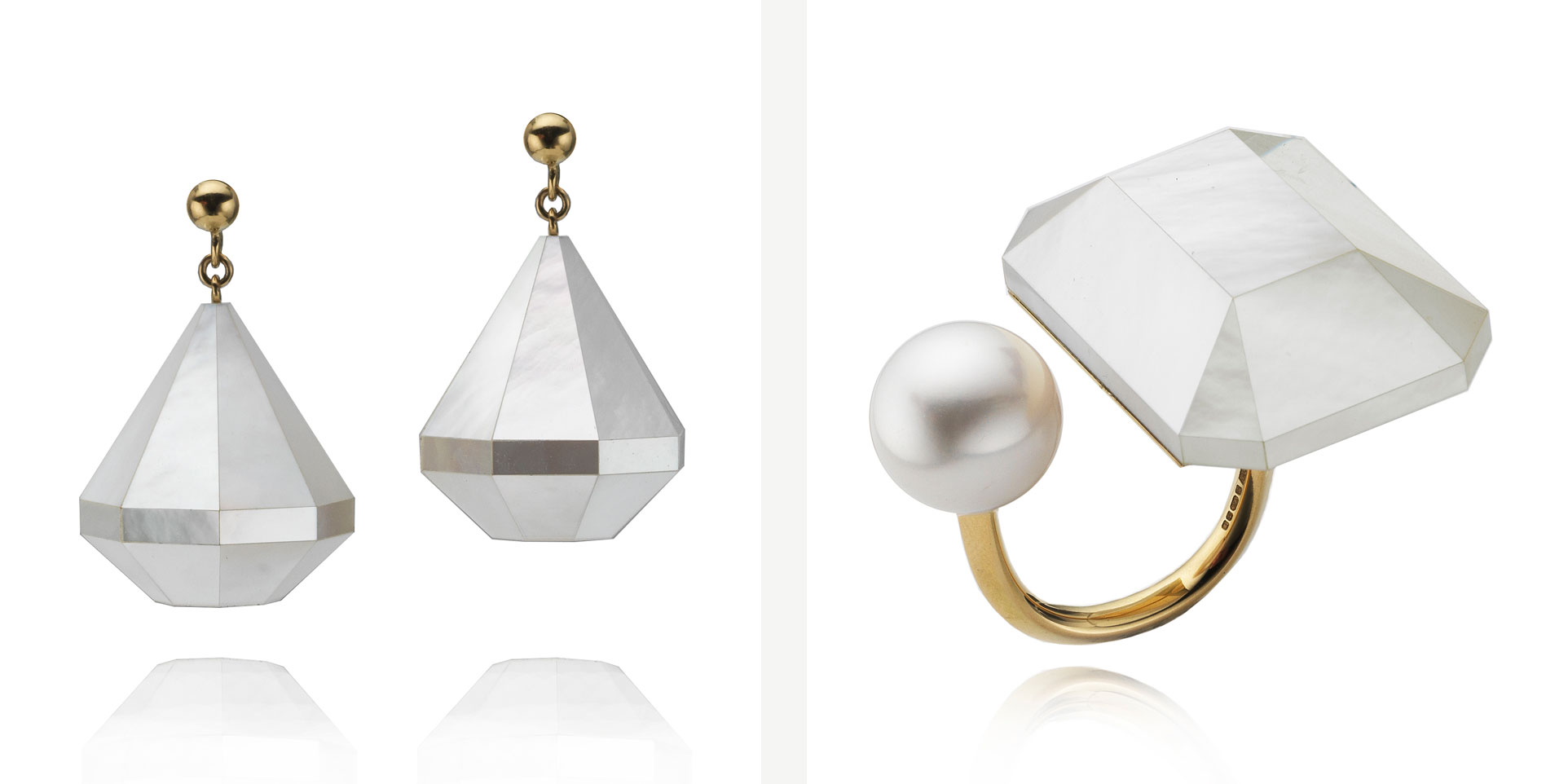
Image 1: MOP Emerald Ring - White
Image 2: MOP Emerald Earrings - White
These pieces are strikingly simple, made of relatively poorly perceived materials, and yet the high craftsmanship and labour intensive production that each piece requires elevates the material far beyond any financial worth one might place on the components.
What drew you to jewellery originally and what’s the Melanie Georgacopoulos design philosophy?
I first studied sculpture and my love of jewellery comes from the fact that it relates to the body. I’m also fascinated by the connection that people have to the jewellery they pass on one generation to another.
One of the reasons I think I may have been subliminally drawn to pearls is that my grandmother wore a pearl necklace every day, and that idea of creating something that is worthy of becoming so intimately connected with a person’s identity really interests me. Good design, for me, is innovation, longevity, and has to represent its time. I strive for this with every piece.
View more jewellery by Melanie Georgacopoulos here. -
Introducing the Lief Collection to Winterson
Introducing the Lief Collection to Winterson
This week we are delighted to launch a new collection of jewellery called Lief, which is also the old English word for "Beloved".
The newly launched Lief collection has been designed by our new Creative Director Alice Cicolini, who first began working with Winterson in 2013.
ALICE CICOLINI
Alice is a successful jewellery designer, creative commissioner and producer, with her work currently being stocked at Net-A-Porter, Dover Street Market, Urban Flower Grange Hall and Colette.
Her first collaborative collection with us called ‘Beau’ - a flamboyantly British range of seed pearl jewellery – is available exclusively at Winterson.
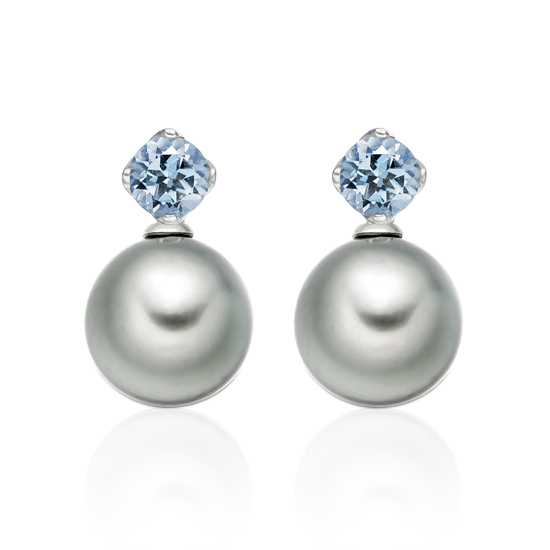
In her official Winterson role, Alice will be responsible for the creative conception and product development of the classic, bridal and fine jewellery collections at Winterson. She will also establish and manage our exclusive collaborations with other up and coming British designers.
Alice brings a distinctive style and influence to our jewellery that has already inspired our customers with her Beau collection, rings and earrings. We are delighted to welcome her fully to our team.
THE INSPIRATION FOR LIEF
The new Lief collection is based on the Winterson brand motif, which is inspired by a wild northern flower called Linnaea Borealis.

This little alpine twinflower is named Carl Linnaeus, a world renowned Swedish botanist who is also believed to have been the first to culture successfully a spherical cultured pearl.
Alice's designs for Lief are an exquisite fusion of colourful gemstones and diamonds with Winterson’s signature pearls. Clever interchangeable design allows the wearer to create different looks across the collection, from everyday to the more formal.
Three designs beautifully capture the essence of spring and colour and will be an exciting range of enduring classics to treasure.
LIEF, ENCHANTED AND ENTWINED
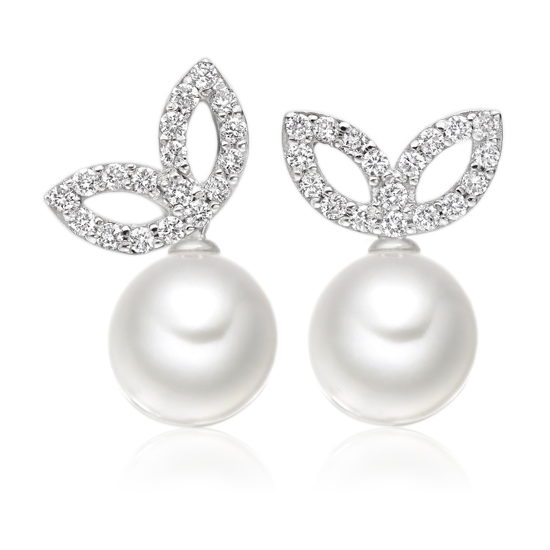
The new Enchanted Diamond Earrings sparkle with 36 ice clear gems and are finished in white and yellow gold. Stunning on their own, they can also be combined with a selection of our carefully chosen pearls, crafted with an 18 carat gold loop and expertly designed to fit the Lief stud earring earpost.
New elegantly understated studs also join the range with a beautiful selection of gemstones to tempt, from soft Morganite and Green Beryl, to vibrant Pink Tourmaline, Aquamarine and Amethyst. Each stud earring can be paired with white Akoya or Freshwater Drop pearls, naturally grey Tahitian pearls, or simply worn on their own.
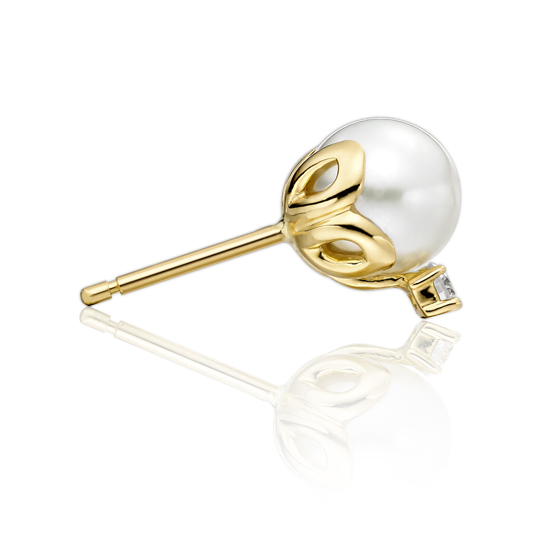
New Entwined Pearl Stud Earrings feature wild gold leaves, entwined around a pair of white Akoya pearls and adorned with two round white sparkling diamonds.
Discover the Lief collection here.
-
Three Pearl Trends For 2014
Three Pearl Trends For 2014
The world of the cultured pearl is always changing, with each year bringing a new set of pearl trends to discover as pearl farmers adapt their production and develop new techniques.
Our buying team recently returned from Asia with a stunning selection of the highest quality pearls for our collections of jewellery at Winterson, being carefully chosen for their lustre, colour and beauty.
But there were a few surprises too.
Here are our reflections from the visit and a prediction of pearl trends for the coming year:
SMALL SIZES…
Pearls above 11mm in diameter command a significant premium for their rarity, particularly for the highest quality South Sea and Tahitian pearls.
But this year more than ever before, we noticed that pearl sizes smaller than 7-8mm diameter, for the Akoya pearl and even seed pearls as small as 1-2mm, are very much in demand for necklaces, earrings and other types of jewellery.
Comfortable to wear and elegantly proportioned, these are the classic pearl sizes for a jewellery designer to work with.
THE EVER CHANGING FRESHWATER PEARL…
The shift in production and demand for Freshwater pearls over the past thirty years has been significant, with small cereal shaped pearls being steadily replaced by the introduction of rounder shapes, and more recently by larger nucleated pearls.
This year really is no exception. Round nucleated Freshwater pearls are now widely available in sizes above 12mm. The trend of the last few years towards large oversized baroque shapes in contemporary jewellery seems to be falling out of fashion.
Perhaps more concerning was the apparent level of processing treatment of some of the larger pearl sizes. Although designed to achieve a whiter colour, these pearls might lose their lustre over time. If in doubt, always buy from a retailer that specialises in pearls.
We only select the highest quality Freshwater pearls that we can find and we loved the dazzling metallic colours of the pearl drops above!
THE NEW WHITE IS…GOLDEN?
The boutiques and shops of Hong Kong are filled with many of the world’s luxury and fashion brands.
The Chinese home market of shoppers loves pearls and prices for high quality pearls are increasing with the growth in Asian markets.
Classic pearls that have a natural-looking white colour are the most favoured style, but it is the luxurious golden South Sea pearl, with its rich tones of champagne, gold and burnt orange, that is the most highly sought after pearl this year.
PREDICTION FOR 2014
The world of pearls is so varied that it is difficult, almost impossible, to summarise one single prediction for this organic gem next year.
Perhaps the most exciting trend is the popularity of small sizes - we are going to see more jewellery designers working with classic white pearls in many subtle, intricate and intriguing ways in 2014.
-
A Peek at the Pearls of Carl Linnaeus
A Peek at the Pearls of Carl Linnaeus
The world of pearls can hold many surprises, but it is not everyday that you have an opportunity to view a historic treasure secured safely beneath the streets of London.
The experimental pearls of famed Swedish botanist Carl Linnaeus are about to join the forthcoming Pearls Exhibition at the V&A and so we jumped at the chance to see these early successful attempts to culture a spherical pearl in close up.
CARL LINNAEUS
Carl Linnaeus (1707-1778) is best known for his method of classifying organisms that uses two latin names to represent the genus and the species, for example 'Homo Sapiens'. This taxonomy is conventionally used today to describe and classify the hierarchical relationships of animals, plants and insects to each other.
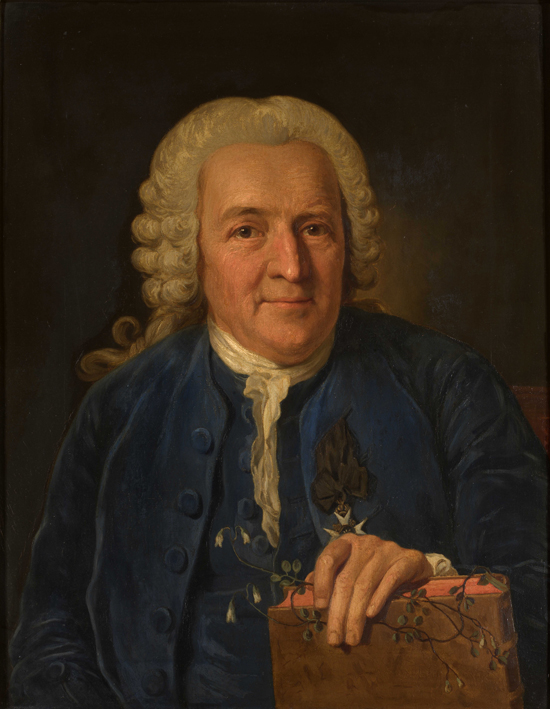
Linnaeus' collections of specimen organisms, including dried flowers, insects, fish and molluscs are unique and are still a primary reference point for scientists to determine if they have found a new species.
Following his death, the Linnean collections were purchased by Sir James Edward Smith in 1784 and transported to London, where they remain today.
THE LINNEAN SOCIETY
In 1788, Smith also founded The Linnean Society to provide a forum to discuss and promote the study of natural history.
The Linnean Society is the world's oldest active biological society. It was at a meeting of the Society in 1858 that papers by Charles Darwin were presented outlining the theory of natural selection and evolution.
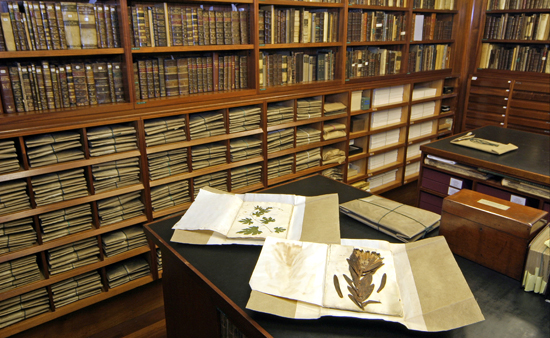
The collections were obtained by the Society in 1829 and are today securely held in a vault below the courtyard of Burlington House, Piccadilly in central London. Leather bound books, old parchment folders and specimen trays line the carefully curated shelves and drawers.
Also in the strongroom was a very rare (and valuable) signed first edition of Charles Darwin's 'Origin of the Species' - a once-in-a-lifetime opportunity to see.
LINNAEA BOREALIS
Carefully wrapped in parchment was this original specimen of Linnaea Borealis, a wildflower of northern and alpine origin that has a distinctive double twin flower shape. The flower is named after Linnaeus as it was a favourite of his whilst travelling in Lapland.
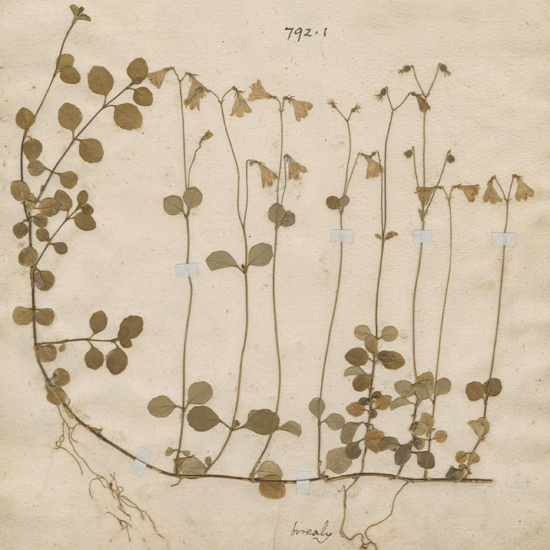
As well as having a beautiful white pink flower, Carl Linnaeus fell in love with the wildflower for the way that it grew persistently in the undergrowth and its ephemeral, short-lived life. These were two symbols that he felt were important in his own life and portraits of Linnaeus, including the one above, and in the Society all feature the Linnaea Borealis.
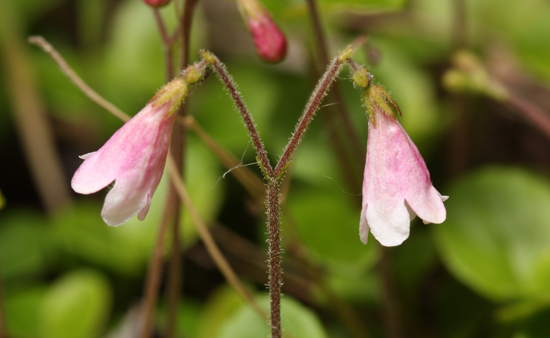
This little flower has a special meaning for Winterson as it was an inspiration for our own flower motif, also honouring its link with Linnaeus and his early achievements in culturing pearls.
LINNAEUS AND PEARLS
Linnaeus declared in 1761 that 'he had heard of people who made gold, but had never heard of any who could make pearls'. Describing the lengthy and time-consuming efforts to find natural pearls that he had seen in Purkijaur, Lapland, Linnaeus believed that a technique for culturing pearls existed that would be more effective and profitable for Sweden.
Linnaeus started to experiment with 'Unio Pictorum', a species of freshwater mussel called the Painter's mussel. This mussel was named as traditionally its shells were used by painters as convenient receptacles for mixing paint.
His technique was a variation of an old Chinese method for producing blister pearls. Drilling a hole in the mussel's shell, Linnaeus inserted a small granule of limestone between the mantle and the shell to help produce a free spherical pearl inside the mussel.
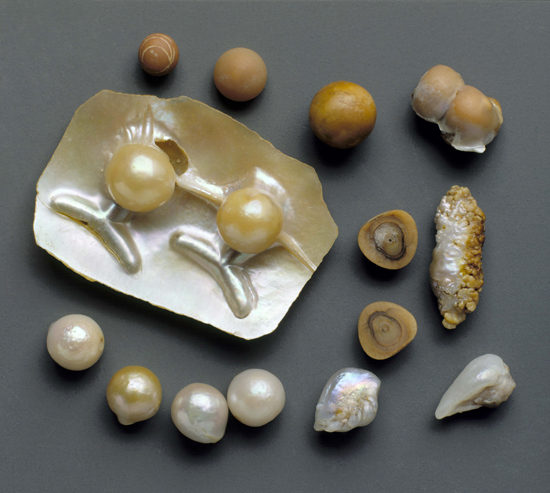
The mussels were returned to the riverbed for six years to produce what is regarded as the world's first spherical cultured pearls. They are indeed historic and fascinating to view.
Linnaeus' method is also based on an old misunderstanding that pearls are created with a grain of sand. We know now that a response to illness or a parasite is the more likely explanation for the growth of natural pearls in an oyster or mussel.
These experimental pearls were not ultimately the source of riches that Linnaeus had hoped for, but he was enobled by the King of Sweden for his efforts taking the title von Linné. The pearls, a patent and Linnaeus' secret were sold to a Swedish merchant named Peter Bagge, but nothing came out of this venture.
Another Londoner Sir John Hunter is recorded as having attempted to culture freshwater pearls in his ponds at Earl's Court Manor House using a similar method to Linnaeus, but it was left to a different Englishman William Saville-Kent to make the next break-through in pearl culturing.
SEE THE LINNAEUS PEARLS AT THE V&A
We would to like thank Elaine Charwat, Deputy Librarian of the Linnean Society for her fabulous help in showing us Carl Linnaeus' pearls.
The pearls themselves are on display soon at Pearls, the V&A's new exhibition. Not to be missed...
-
Pearls Exhibition at the V&A Museum
Pearls Exhibition at the V&A Museum
With much excitement and anticipation, the Pearls exhibition at the V&A Museum opens later this month in London.
PEARLS EXHIBITION AT THE V&A
Promising to be one of the biggest Autumn shows, the exhibition will show off the luxurious qualities of some of the world's most unusual and valuable pearls and jewellery, as well as exploring the unique heritage and impact on popular culture of this beautiful gem.
We are very fortunate to be able to ask Beatriz Chadour-Sampson and Hubert Bari, the curators of the Pearls exhibition, about the show and what a visitor can look forward to. We would like to thank them, the V&A and the Qatar Museums Authority for their support with this article.
Here are Beatriz and Hubert's thoughts on 'Pearls'.
How special has this exhibition been for you and to curate? What did you hope that its visitors may learn about pearls?
From all gems, it is the most unusual as the natural pearl is produced by living animals. Even cultured pearls after human intervention are created by nature. Visitors will be amazed to learn that, in principle, any mollusc can produce a pearl from the giant clam to the land snail, and they will be dazzled by the variety of shapes and colours of pearls.
The history of the trade of pearls between continents is fascinating, and how East and West share the same passion for pearls.
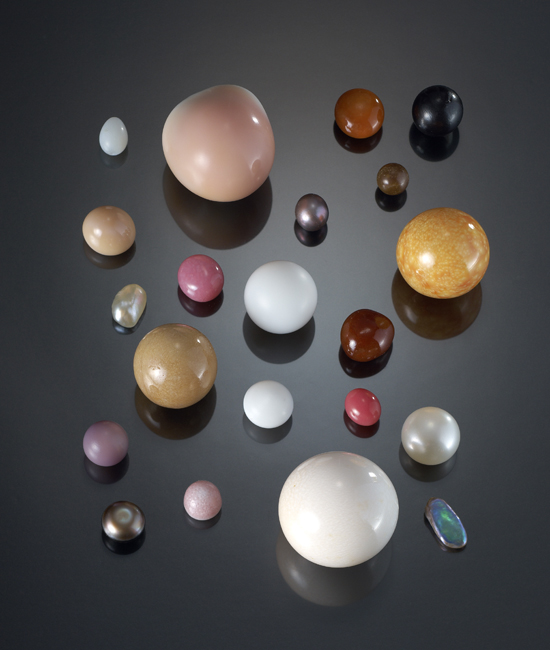
Pearls have a unique symbolic significance and mystique. Can the pearl claim to be the world's favourite gem?
Incredibly, pearls have created a global fascination over millennia, like no other gem. There is something magical about pearls, their beauty lies in their perfection of form and most of all lustre. They are born in the form that nature made them with a natural sheen.
Pearls have always been a symbol of femininity. Maybe this is the reason why the fashion for pearls continues today.
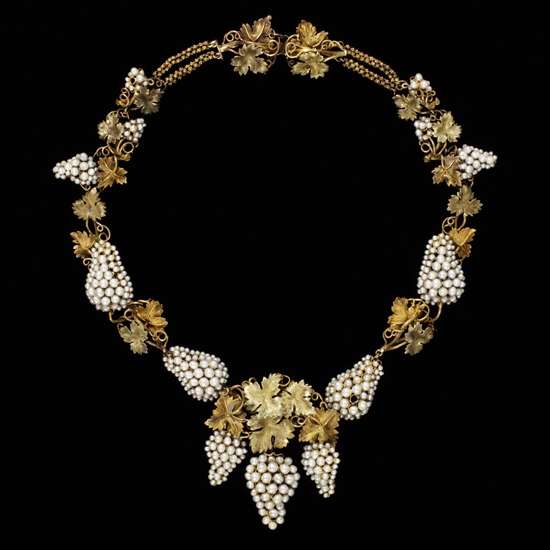
The exhibition showcases many famous examples of pearl jewellery, many styles of which are still being referenced today in popular culture. Have we already seen a 'golden age' of pearl jewellery design or is the pearl a gem that will be constantly reinvented?
Yes, as no other gem has been worn as consistently, as pearls. Pearls are neutral and versatile, appropriate for any occasion. In previous years jewellers have shown a persistent, if not renewed interest in creating new designs with pearls.
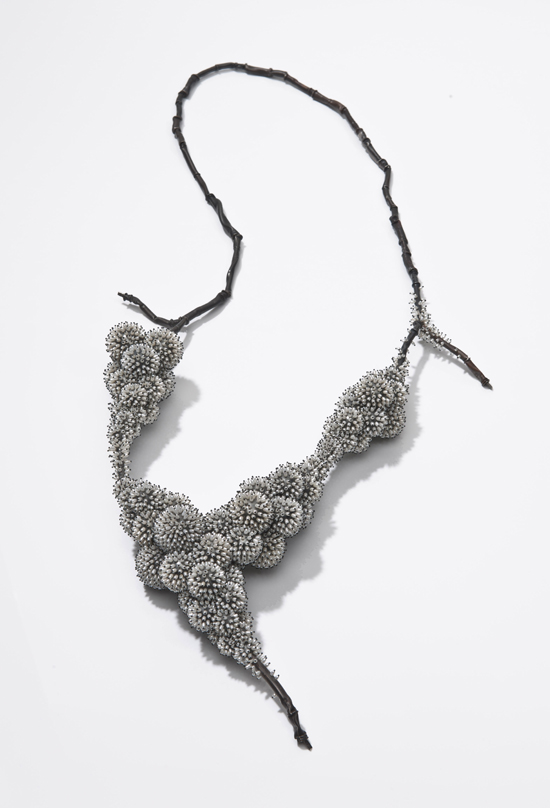
What is the most striking or surprising aspect for you about the history of the pearl?
The fascination for pearls and wish to wear these beauties of nature transcends cultures and borders. The similarities in the myths and legends surrounding the pearl in East and West are astonishing. Pearls mark authority and power, symbolize prosperity and on a more personal note they are associated with joy at weddings or tears as a sign of mourning.
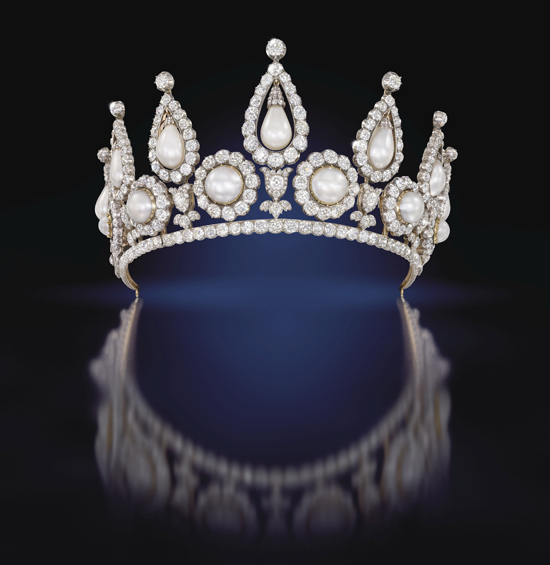
Natural pearls have undergone a renaissance in the last decade, achieving spectacular prices at auction, and cultured pearls are being produced in better, more diverse and beautiful qualities. What does the future hold for this gem?
The future of the pearl depends on so many factors, not least the condition of our seas. Natural pearls are simply too rare and expensive, only affordable to the very few. Today China produces such quantities of cultured pearls of inferior quality, that they are endangering the pearl market. Whilst they give great care when creating one pearl from an oyster, the Chinese produce 50 in one mussel, at low cost in rice fields or near housing estates. In South East Asia the farms which produce the beautiful South Sea pearls are experiencing not only financial difficulties but the effects of pollution and for these reasons their future remains uncertain.
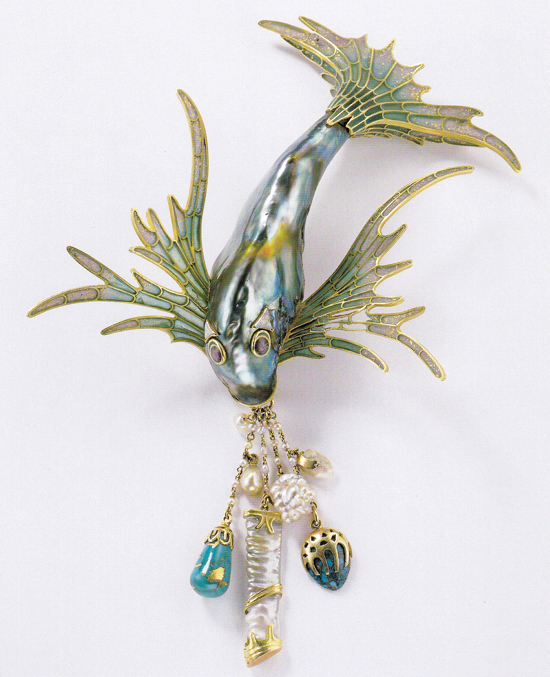
The desire for pearls has been so insatiable that imitation pearls have existed over centuries and their advocate in the 1930s Coco Chanel was instrumental in reviving the fashion for pearls and revived the industry at a time when this was unthinkable. No one can tell what the future will hold for this beautiful gem, but the fashion for pearls endures.
The 'Pearls, V&A and Qatar Museums Authority Exhibition', runs from 21 September 2013 to 19 January 2014 as part of the Qatar UK 2013 Year of Culture.
To learn more about the exhibition, visit the V&A website here.
-
Fascinated by Pearls: William Saville-Kent
Fascinated by Pearls: William Saville-Kent
One of the most influential and unsung pioneers of the modern day cultured pearl industry was an Englishman called William Saville-Kent.
Many popularly associate Kokichi Mikimoto with the discovery of the technique to culture a spherical pearl in the early 20th century. But the intriguing truth of the race to discover how to mimic nature's process of creating a spherical pearl is far less clear, even today.
By the late 1890s, the pearling industry in Queensland, Australia was in real trouble. Although the sixth largest industry in Queensland in 1884, its export value had almost halved within the next 5 years. The coral and oyster beds off the northern coasts of Australia and the Torres Strait between Australia and New Guinea were sadly being depleted by divers and fishing fleets in search of valuable natural pearls and mother-of-pearl shell for use as buttons.
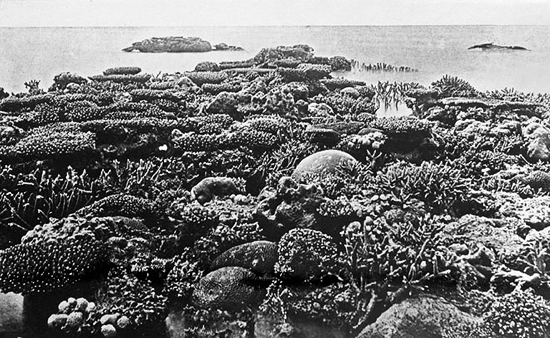
William Saville-Kent was a marine biologist with considerable experience of surveying and managing fish and oyster stocks. Over a period of 15 years, he was appointed by the British Colonial Government as Inspector of Fisheries in Tasmania (1884-87) and Commissioner of Fisheries for both Queensland (1889-92) and Western Australia (1892-95).
One of his main roles was to report on the increasingly difficult economic and environmental situation facing the pearling industry, introducing systems for licensing fishers, regulations for protecting the smaller sizes of the catch and creating protected government reserves for the longer-term sustainability of this natural resource.
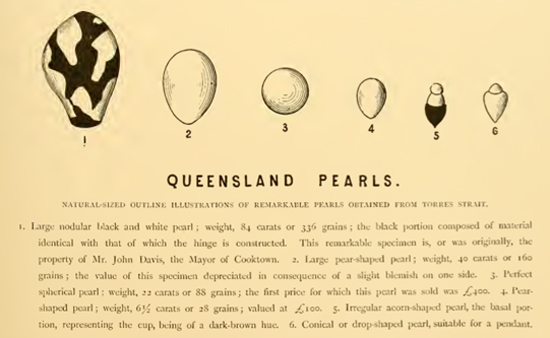
Saville-Kent was also a practical naturalist and was the first to recognise the difference between the silver and gold-lipped Pinctada maxima South Sea pearl oyster and the black-lipped Pinctada margaritifera cumingii Tahitian pearl oyster.
Beginning his experiments in 1889 at Thursday Island in the Torres Strait, the centre of the Queensland pearling industry, Saville-Kent would have been very aware of the impact that his work could have on the industry that he was so fascinated with. In this extract above from his 1893 book The Great Barrier Reef, he describes a single perfect spherical pearl (number 3) with a market value then of £400, worth approximately £40,000 adjusted for inflation today.
By 1891, Saville-Kent had successfully produced a number of cultured blister pearls and exhibited these in London. This was two years before Mikimoto had cultured five semi-spherical pearls in Japan.
Returning from London in 1905, with a syndicate called 'The Natural Pearl Shell Cultivation Company of London', a commercial cultured pearl farm was established near Torres Straits. Saville-Kent and his financial backers were convinced that they had the secret of how to produce a spherical cultured pearl.
There were by now others, however, with the same objective and this unique commercial and scientific race had begun...
-
What are Peacock Pearls?
What are Peacock Pearls?
The very name itself - Peacock Pearls - conjures up an image of an iridescent, beautiful gem with a myriad of shimmering colours. Are these pearls real and what are the qualities that give Peacock Pearls their colourful name?
A peacock pearl describes one of the most valued and sought after colours of a type of saltwater pearl called the Tahitian pearl, which are cultured in French Polynesia in the black-lipped oyster Pinctada margaritifera.
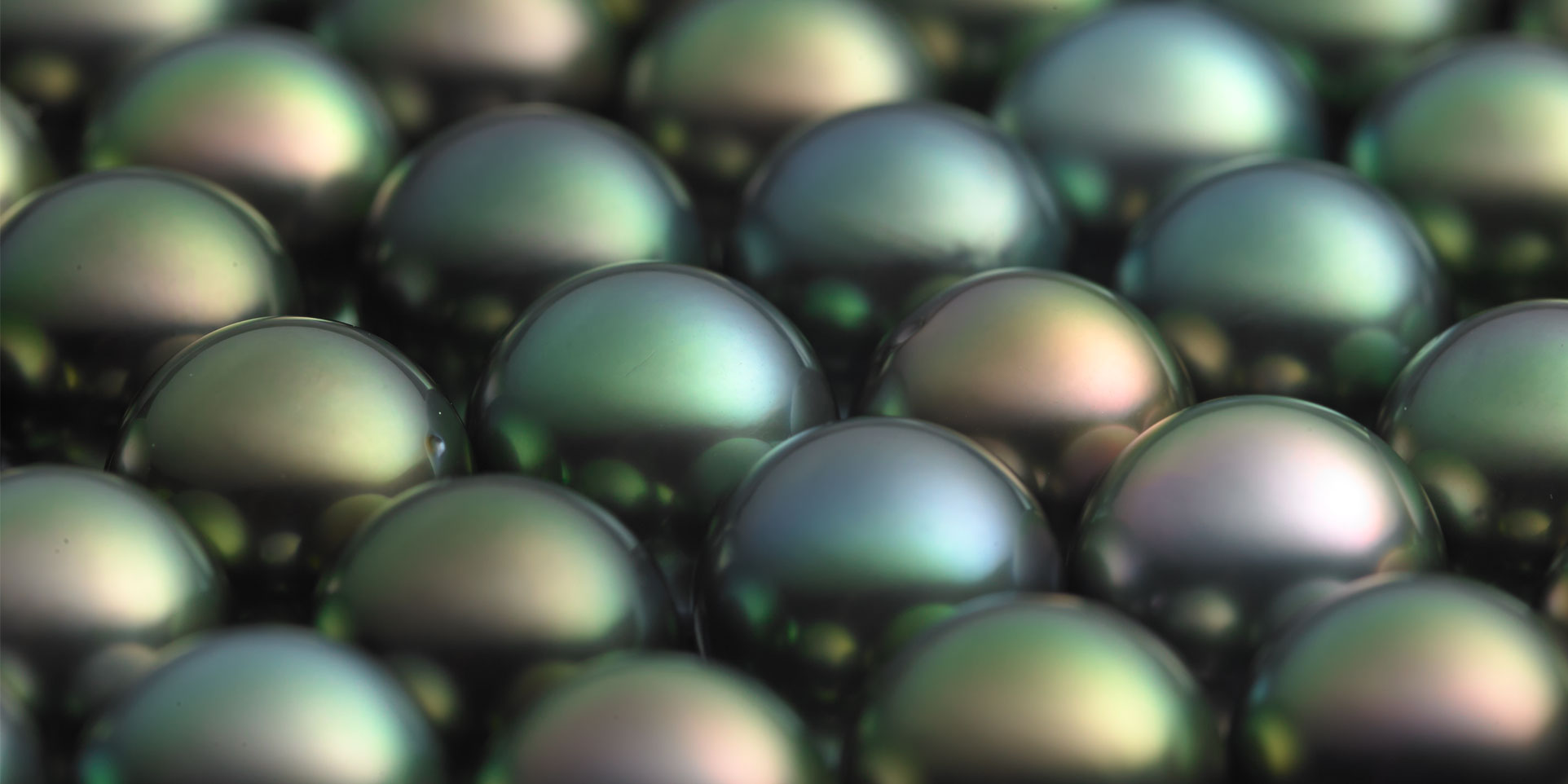
Image: Peacock Tahitian Pearls
With a dark grey-green body colour, a true peacock pearl will have a pink, purple or golden overtone of colour that appears to float on the surface of the pearl as the light catches it. These natural iridescent colours are achieved without any artificial dye or treatment.
What causes these special colours?
The dark body colour of the Tahitian pearl comes from the pigments and trace elements in the water that the oyster lives in.
The reason for the colour and strength of the overtone of each pearl, however, also depends on other factors. Scientists believe that the peacock's striking plumage is thought to be caused by the different ways that light is reflected at angles by the structure of the bird's feathers. Just as with the peacock, the layers of nacre on the curved surface of a pearl can have the same effect.
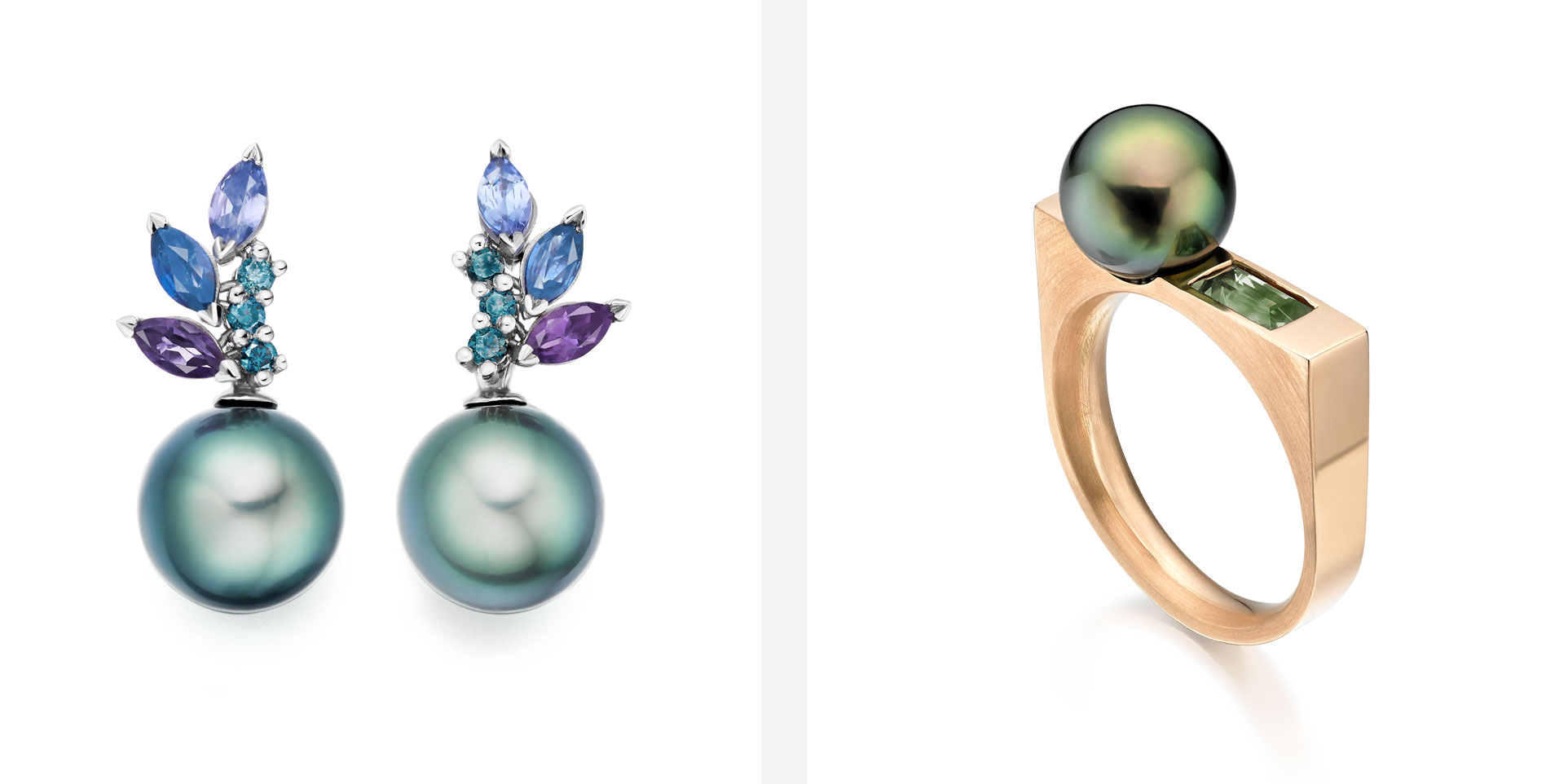
Image 1: Enchanted Lagoon Earrings in White Gold
Image 2: Luna Moss Tahitian Pearl and Sapphire Ring
Optical interference creates the complexity of each pearl's colour. The shape of the pearl, and the thickness and transparency of its nacre, can contribute in varying degrees to the colour's intensity.
Artificial colour treatments for peacock pearls
Since pearls were cultured early in the 20th century, there have been many attempts to reproduce artificially the peacock colours of a Tahitian pearl.
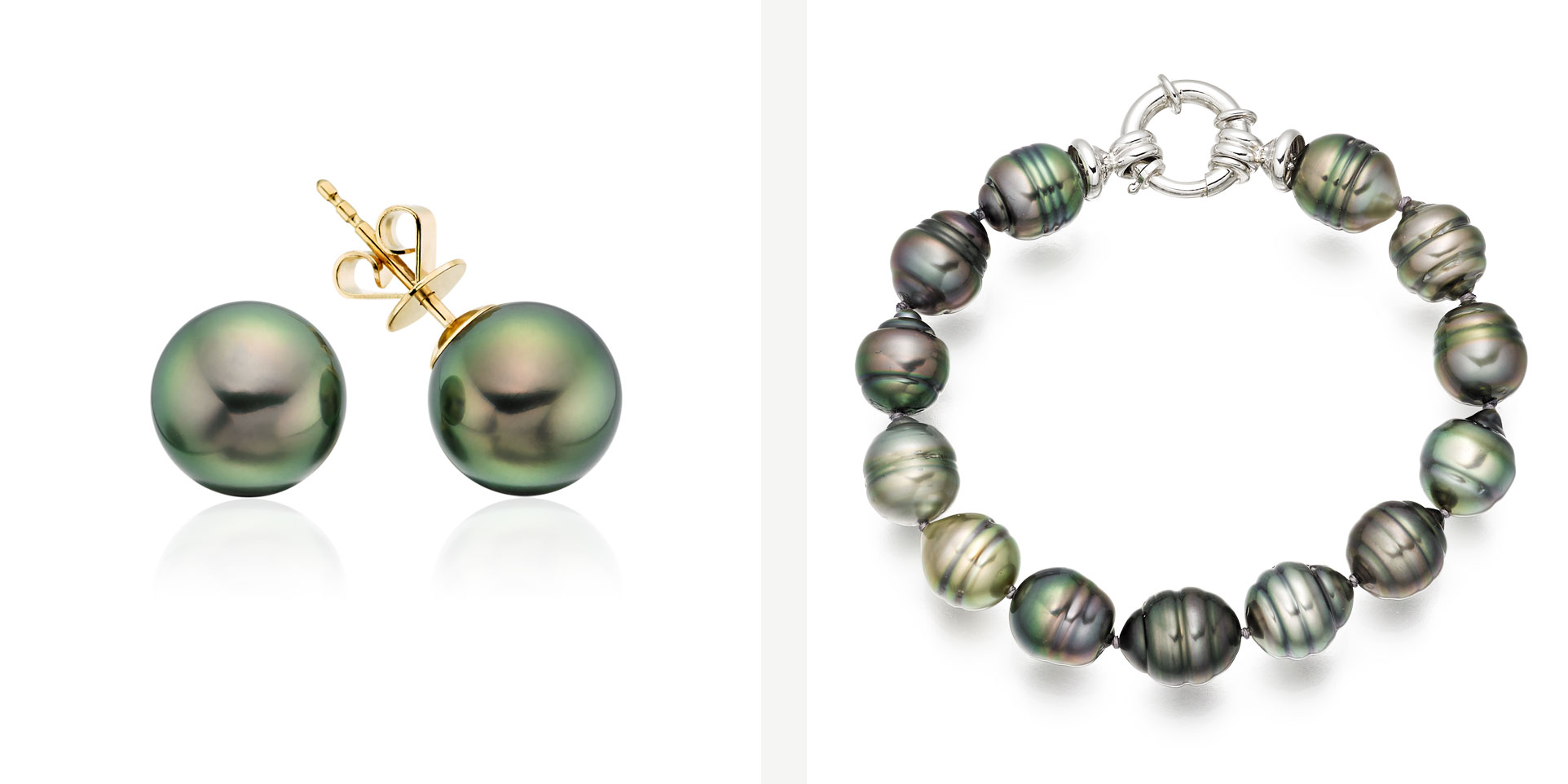
Image 1: Peacock Tahitian Pearl Stud Earrings in Yellow Gold
Image 2: Multi-coloured Baroque Tahitian Pearl Bracelet in White Gold
The exact techniques used are not well-known, but may involve the use of silver nitrate solutions to darken the pearl, other colouring agents such as organic dyes to produce a blue, purple, green or brown hue or gamma ray irradiation to darken the pearl itself.
Many black pearls sold today are Chinese freshwater pearls that have been treated. These treatments would be quite obvious to an experienced pearl expert or retailer as they are not an exact match to the real peacock colouring. Some dye treatments may also show some colour differences or fading over time, so ask your retailer if unsure.
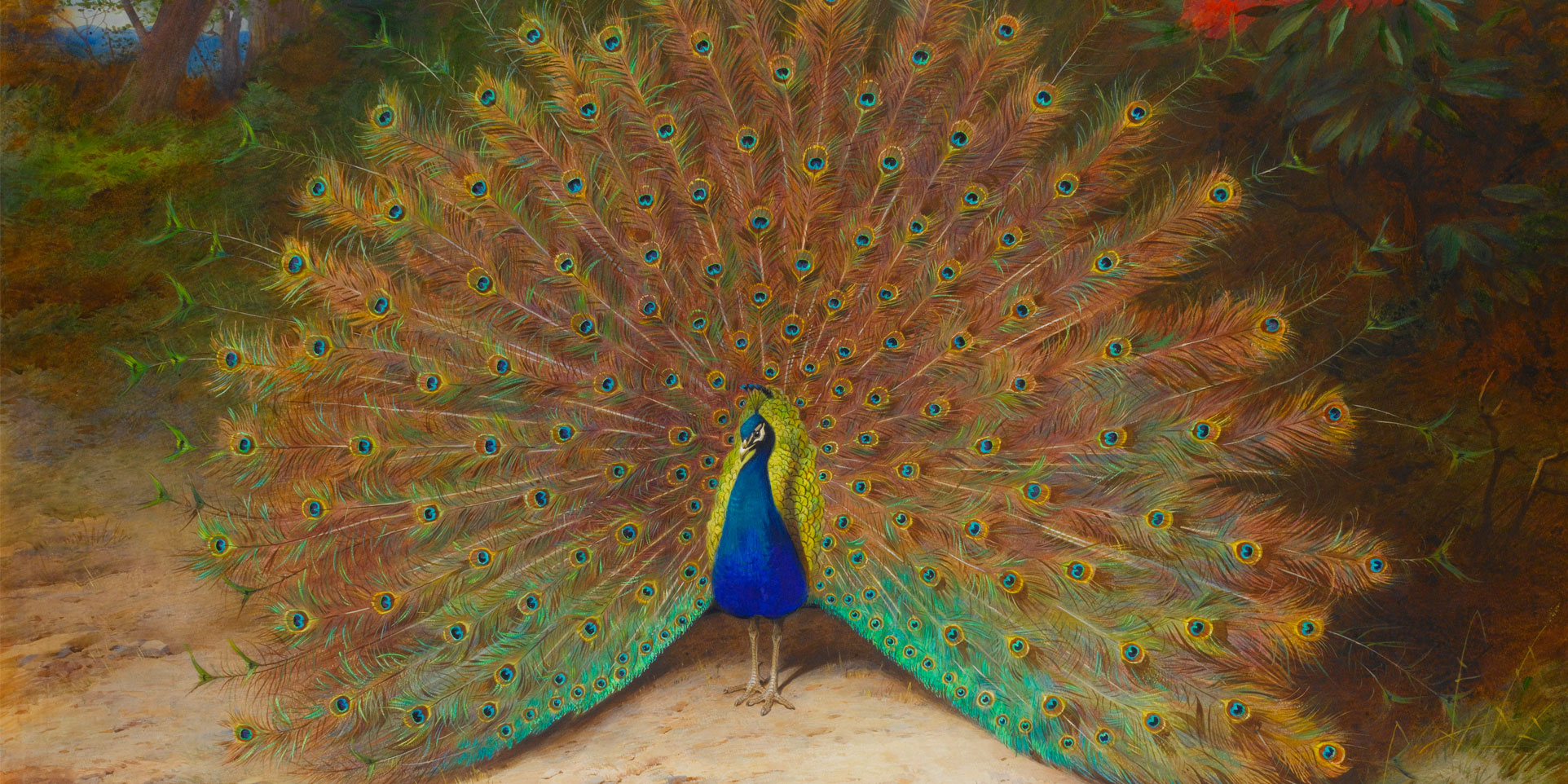
Image: Peacock and Peacock Butterfly, Archibald Thornburn, 19th century
Genuine Tahitian pearls are also prized for their relative rarity in comparison to freshwater pearls, and, like the silvery-white and golden South Sea pearls, are considered to be some of the finest examples of this extraordinary gem.
As with all rare pearls, this is reflected in their relative pricing, which is another way to distinguish this queen of gems from the dyed freshwater variety.
Proud as a peacock
We love the more natural colours and overtones of the peacock pearl and have a beautiful range of jewellery at Winterson that showcases the extraordinary natural rainbow overtones of these amazing peacock pearls.
Read our Journal article on Selecting Fine Pearls if you would like to know more.
-
What are the Best Pearls to Buy?
What are the Best Pearls to Buy?
With a heritage of working with pearls for over 50 years, one of the most frequent questions that we are asked at Winterson is what are the best pearls to buy. In this article we look at the most popular types of pearls and some tips to consider.
The classic pearl
The most popular image of the pearl is the classic round white pearl, draped in long elegant flowing strands, worn as a pretty stud earring or as a symbolic piece of jewellery for a new bride.
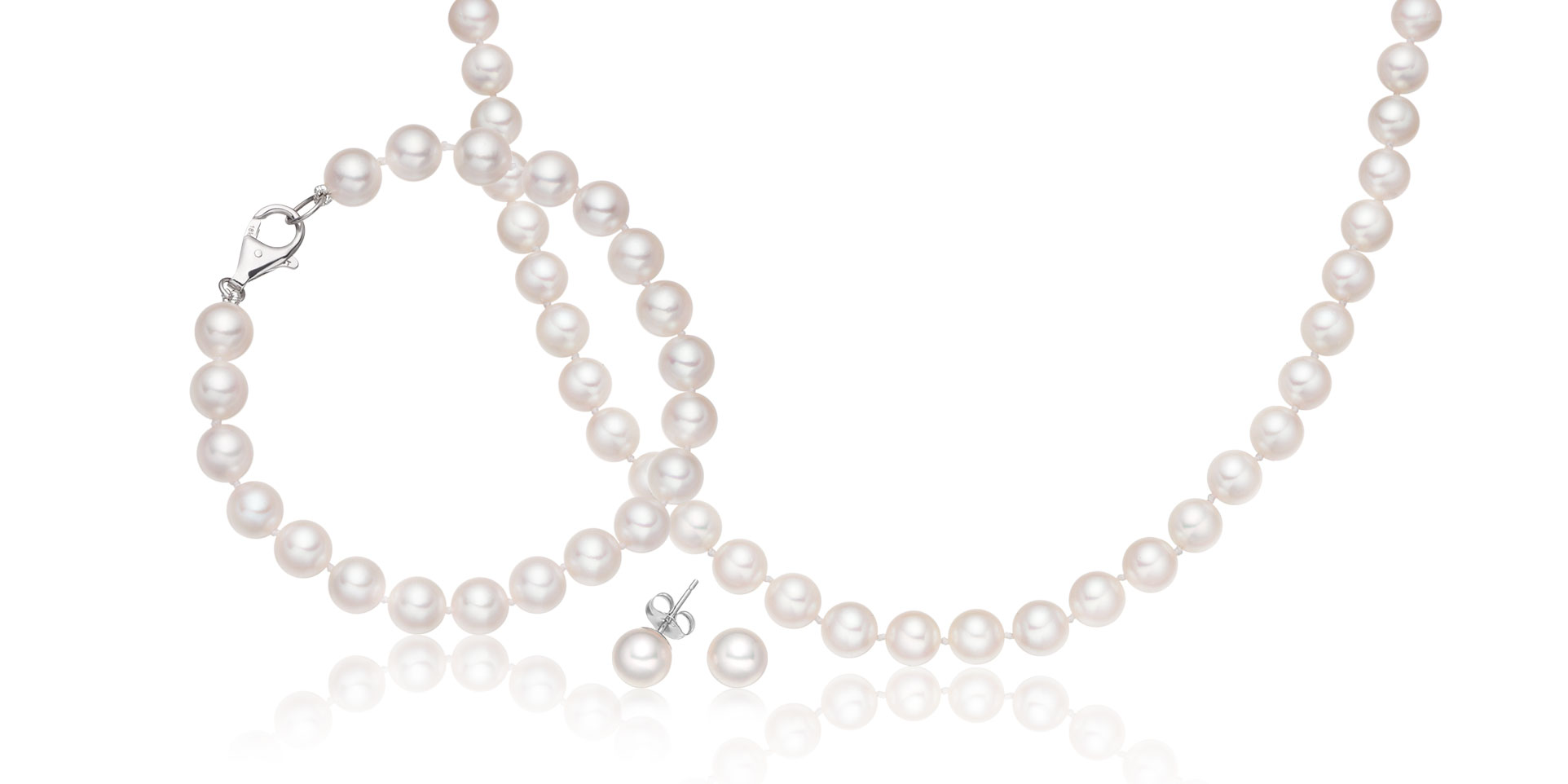
Image: Classic Akoya Pearl Jewellery Set
These styles will always be fashionable and versatile, but there are many other wonderful colours, sizes and shapes of pearls to buy. Before making a decision, it can be worthwhile exploring a little more about this beautiful gem.
Types of pearls
There are four main types of cultured pearl, including Freshwater pearls and three types of saltwater pearl known as Akoya pearls, Tahitian pearls and South Sea pearls.
Their size can range from as little as 1.5mm in diameter to as much as 20mm in diameter, with round, drop, oval and asymmetric baroque shapes. Their natural colours can include creamy whites, pastel shades of pink, peach and apricot, cooler hues of silver, grey, blue, purple and black and the warm opulence of gold.
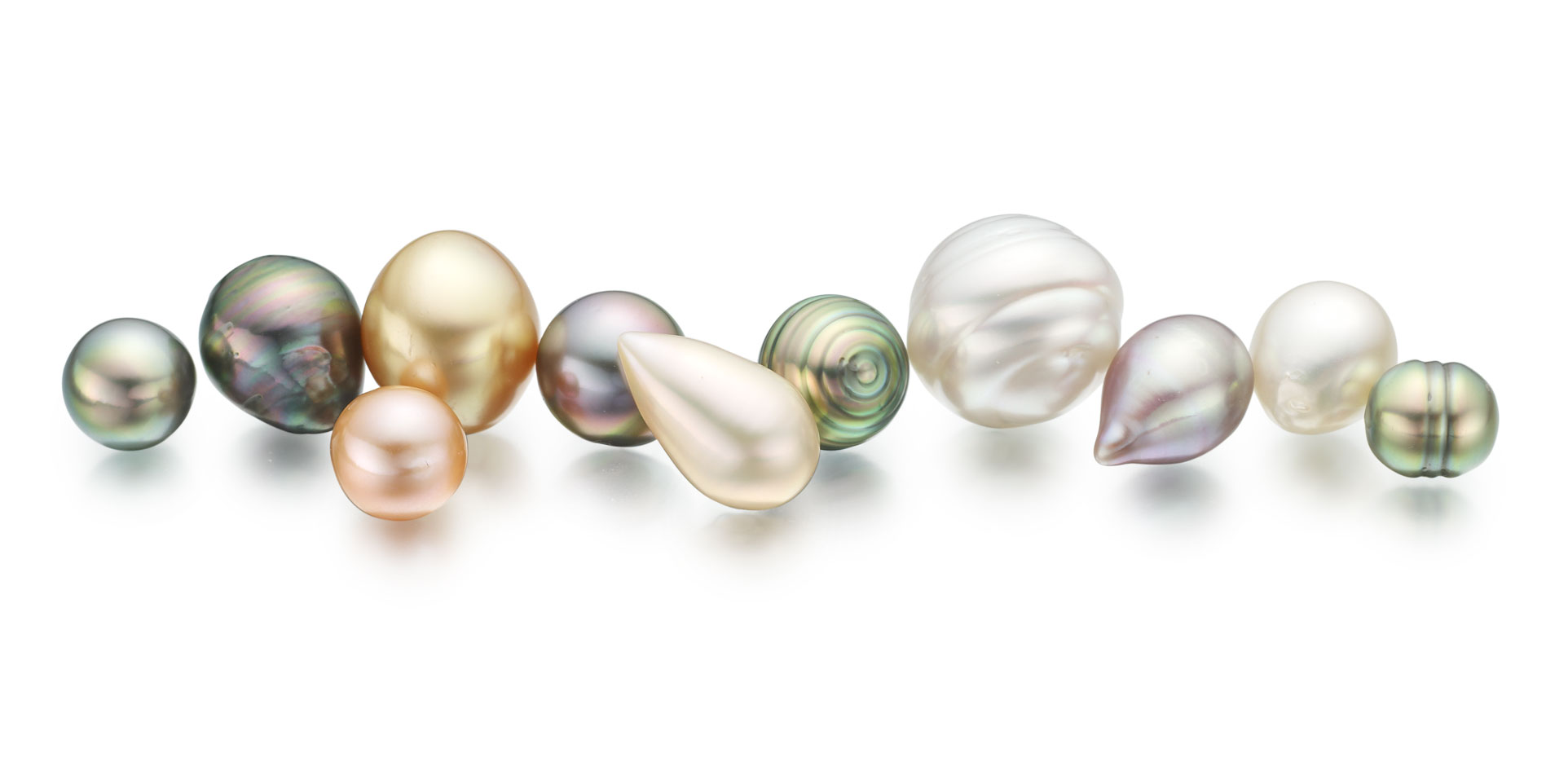
Image: Freshwater and Saltwater Pearl Shapes
Each pearl will also have been carefully cultured in a mussel or oyster for between 6 months and 3 years and their quality, uniqueness and rarity will increase their value. The difference in price between a small pearl with poor lustre and a perfectly round, excellent lustre pearl can be significant.
Is there a best pearl to buy?
There really is no straightforward answer as to 'what are the best pearls to buy' or 'what are the best pearls in the world'. If you are thinking of purchasing or wearing a piece of pearl jewellery, our advice would be to always consider the grading of the pearl, particularly its lustre, and how the design of the jewellery complements the pearl.
Pearl grading
Choose a piece of pearl jewellery that has been graded by an expert. There are several different grading systems used across the industry. We use the GIA Pearl Description System to describe the pearls in our jewellery, as this is one of the best known and reputable.
We also contract an independent organisation called Feefo to ask all our customers for their genuine feedback on each purchase from Winterson. This feedback is unedited by us and is published on our and Feefo's websites, acting as a marker of the quality you can expect from a Winterson pearl.
Do be careful when no information about a pearl is presented or when a pearl is described as being of AAAA quality.
The importance of lustre
Lustre is a grading factor that is used to describe how a pearl reflects light from its surface. This is one of a pearl's best qualities and is quite unlike any other gem. The best pearls to buy should have lustre that is sharp and mirror-like, catching the light and the eye.
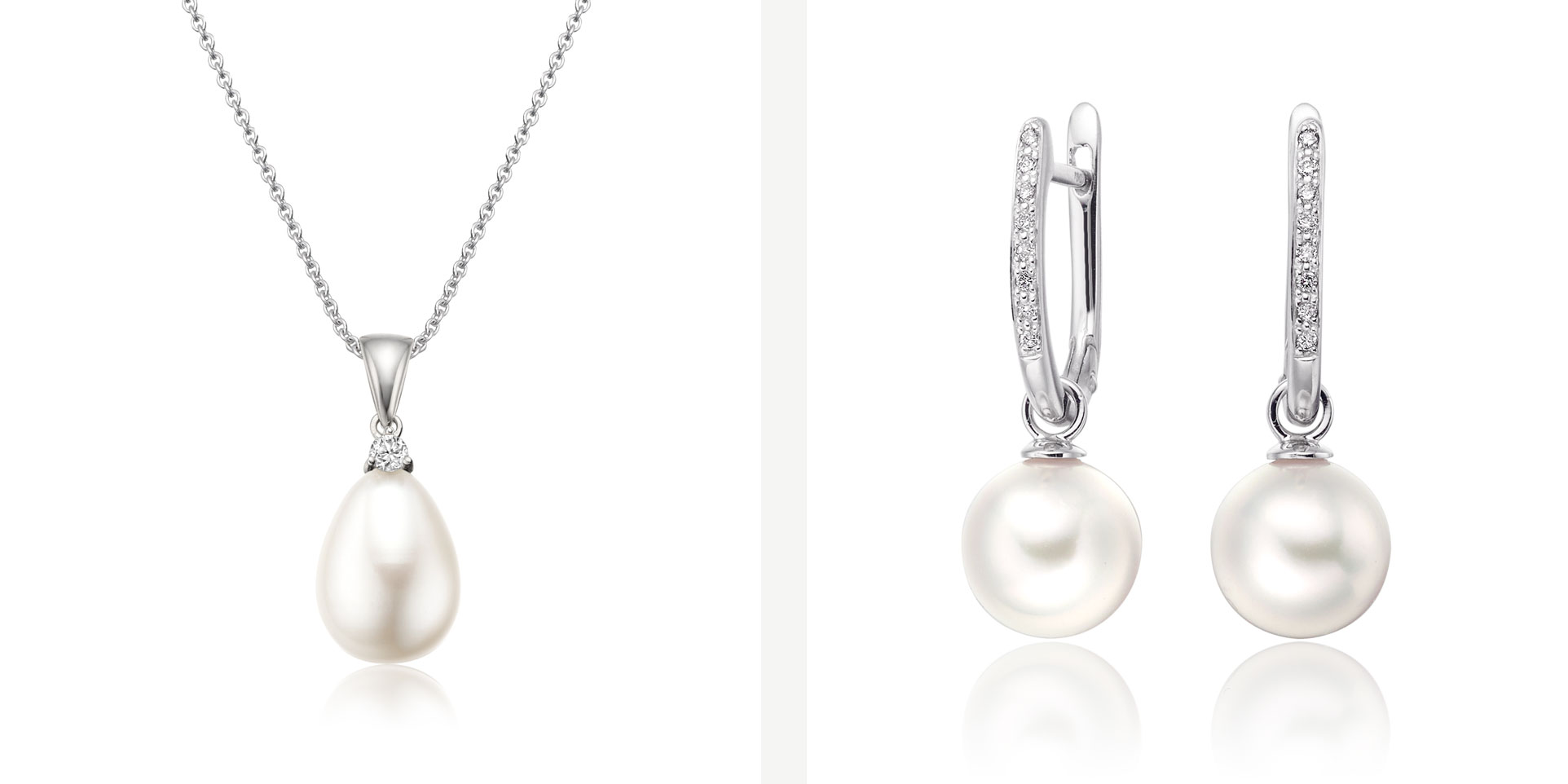
Image 1: Freshwater Drop Pearl and Diamond Pendant in White Gold
Image 2: White Gold Diamond Leverback And Akoya Pearl Earrings
One of our favourite pearls is the classic Akoya pearl, which is admired for its stunning lustre, as shown above with our Leverback earrings.
Beautiful jewellery design
Our third recommendation would be to choose a design that shows off the best features of the pearl. For example, we love the way that our Luna Rose Tahitian Pearl and Sapphire Ring, pictured above, contrasts the round shape and unusual aubergine colour of the Tahitian pearl with the rectangular shape and candy colour of the pink sapphire gem.
Using colourful gemstones to draw out the pearl’s myriad overtones is one technique that we use at Winterson. You can read more about our design inspirations and how we work with colour here.
If you have any questions about the best pearls to buy, our jewellery or our website, our Customer Care team would be happy to help you. Or learn more about the different Types of Pearls in our Guide to Buying Pearls here.
-
Blue Pearl Secrets of the Abalone Sea Snail
Blue Pearl Secrets of the Abalone Sea Snail
Abalones are large sea snails with a secret. Brown and grey on the outside, and covered in seaweed, they hide a world of iridescent blue pearl colour inside their shells.
Abalones are a variety of marine gastropod, resembling a typical garden snail and carrying a single spiralled shell on its back. They live in shells that are up to 20 or 30cm in size and can survive in both cool and warm saltwater tidal zones.
Also considered a delicacy by some, Abalones are typically found off the coasts of Western USA, Mexico, Japan, Korea, South Africa, Australia and New Zealand. Although most live for 10 to 20 years, they can reach as much as 40 or 50 years in age.
Along with Conch snails and Melo melo, Abalones are also one of the few gastropods that are capable of producing pearls. As with pearls that are formed by a mollusc such as an oyster, an Abalone's pearls are made by depositing thousands of layers of an organic substance called nacre.
The surface of their inside shell, also called mother-of-pearl, shimmers with a kaleidoscope of blues, greens, pinks, silver and purple. The dark lines that weave across the surface of the shell, and linking its colours and texture together, are made with conchiolin, an organic protein that helps form a pearl's nacre.
Natural Abalone pearls are very rare. The unique colours of these blue pearls and their baroque horn shapes are highly sought after by jewellery collectors. One of the largest natural Abalone pearls ever found is the Big Pink Pearl, which was valued in 1991 at $4.7 million. Symmetrical round Abalone pearls are even more unusual and can take many years to form.
Attempts to produce cultured pearls with Abalones have been recorded since the late 19th century. The principal Abalone pearl farms today are in California and New Zealand, where the native paua is used to produce beautiful blue pearl mabe.
Culturing a saltwater pearl requires years of investment, technique, experimentation and pristine environmental conditions. But the challenges for Abalone pearl farmers are even harder as the animal is particularly sensitive to injury.
Blue pearl mabe are more frequently cultivated by pearl farmers as the procedure for making a blister pearl is more successful and less invasive to the Abalone. These beautiful cultured mabe pearls can be made into a unique collection of pendants, rings and earrings.
It would be almost impossible today to collect a sufficient quantity of round Abalone pearls to match and make into a conventional pearl necklace. Imagine how amazing and unique the colours of that piece of jewellery would be!